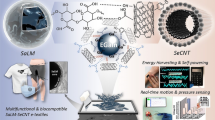Abstract
Nonwoven-based microfluidics is an emerging field in low-cost microfluidics as another alternative to paper-based microfluidics. Comparing with the conventional paper material that has been widely used in low-cost microfluidics, the cost of nonwoven fabric material is the same range, but with the advantages of higher mechanical strength and a wider choice of chemical/physical properties. In this study, we proposed a novel method for defining a programmable and single-use wax valve on nonwoven-based microfluidic devices. The nonwoven-based microfluidic devices were fabricated using wax-printing and thermal reflow approach to define the basic microchannels for fluid penetration. Then, another layer of wax material contain valve structures were deposited on the surface of the microchannels, each wax valve structure has a corresponding heater resistor that can trigger the wax penetration to block (close) the microchannel. With the controlled thermal actuator operation, the fluid penetration inside the porous media of nonwoven fabric microchannel can be programmed with the control of wax valves. A chemical method for reopening the microchannels was also introduced in this study. The proposed programmable wax valve on nonwoven-based microfluidics is easily accessible with low-cost for point-of-care applications in biological and medical fields.







Similar content being viewed by others
Reference
Zilionis R et al (2017) Single-cell barcoding and sequencing using droplet microfluidics. Nat Protocols 12(1):44
Duncombe TA, Tentori AM, Herr AE (2015) Microfluidics: reframing biological enquiry. Nat Rev Mol Cell Biol 16(9):554–567
Hou X et al (2017) Interplay between materials and microfluidics. Nat Rev Mater 2(5):17016
Sanjoh A, Tsukihara T (1999) Spatiotemporal protein crystal growth studies using microfluidic silicon devices. J Cryst Growth 196(2–4):691–702
Schabmueller C et al (1999) Design and fabrication of a microfluidic circuitboard. J Micromech Microeng 9(2):176
Faustino V et al (2016) Biomedical microfluidic devices by using low-cost fabrication techniques: a review. J Biomech 49(11):2280–2292
Martinez AW et al (2009) Diagnostics for the developing world: microfluidic paper-based analytical devices. ACS Publications, Washington
Smith S, Madzivhandila P, Ntuli L et al (2019) Printed Paper-Based Electrochemical Sensors for Low-Cost Point-of-Need Applications. Electrocatalysis 10:342–351. https://doi.org/10.1007/s12678-019-0512-8
Gong MM, Sinton D (2017) Turning the page: advancing paper-based microfluidics for broad diagnostic application. Chem Rev 117(12):8447–8480
Yamada K et al (2017) Toward practical application of paper-based microfluidics for medical diagnostics: state-of-the-art and challenges. Lab Chip 17(7):1206–1249
Yang Z et al (2018) Rapid veterinary diagnosis of bovine reproductive infectious diseases from semen using paper-origami DNA microfluidics. ACS sensors 3(2):403–409
Younas M, Maryam A, Khan M et al (2019) Parametric analysis of wax printing technique for fabricating microfluidic paper-based analytic devices (μPAD)for milk adulteration analysis. Microfluid Nanofluid 23:38. https://doi.org/10.1007/s10404-019-2208-z
Fan Y et al (2018) Rapid prototyping of shrinkable BOPS-based microfluidic devices. Microfluid Nanofluid 22(12):136
Fu E et al (2010) Controlled reagent transport in disposable 2D paper networks. Lab Chip 10(7):918–920
Songok J, Toivakka M (2016) Controlling capillary-driven surface flow on a paper-based microfluidic channel. Microfluid Nanofluid 20(4):63
Giokas DL, Tsogas GZ, Vlessidis AG (2014) Programming fluid transport in paper-based microfluidic devices using razor-crafted open channels. Anal Chem 86(13):6202–6207
Li X, Tian J, Shen W (2010) Progress in patterned paper sizing for fabrication of paper-based microfluidic sensors. Cellulose 17(3):649–659
Acknowledgements
This work was supported by the supported by the National Natural Science Foundation of China (81871505, 61571420, and 51804014).
Author information
Authors and Affiliations
Corresponding author
Additional information
Publisher's Note
Springer Nature remains neutral with regard to jurisdictional claims in published maps and institutional affiliations.
Rights and permissions
About this article
Cite this article
Zhang, J., Huang, L., Fan, Y. et al. Programmable thermally actuated wax valve for low-cost nonwoven-based microfluidic systems. Microsyst Technol 26, 3847–3853 (2020). https://doi.org/10.1007/s00542-020-04873-y
Received:
Accepted:
Published:
Issue Date:
DOI: https://doi.org/10.1007/s00542-020-04873-y




